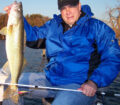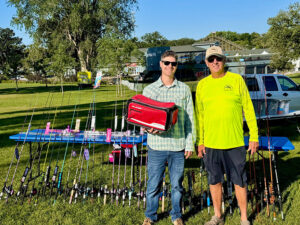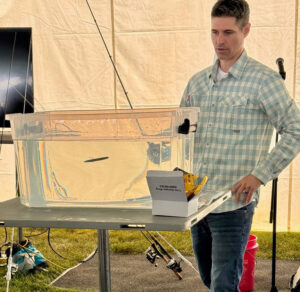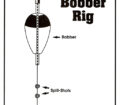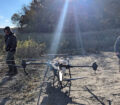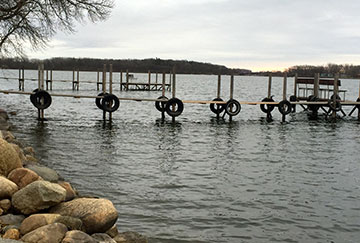By Steve Weisman
Wow! What else can I say about Dan Spengler’s Fishing Seminar (The Art and Science of Fishing) held at the Okoboji Blue Water Festival on Saturday, August 10 except…Wow! From the great fishing seminar weather to the great crowd of over 350 people to Spengler’s fishing knowledge to nearly $10,000 in Berkley/Pure Fishing’s quality fishing tackle…what a morning!
Most definitely “The Art and Science of Fishing” seminar, which was held at 10 a.m., at last Saturday’s Okoboji Blue Water Festival, provided fishing enthusiasts an awesome opportunity to learn a wide range of fishing presentations. With so much information to share, I feel the need to make this a two-part story. Here is the first part.
Spengler’s bait making history
Although Spengler has been designing hard baits at Pure Fishing for 14 years, he was actually fascinated with making lures from age nine. Using a pocket-knife, he would whittle and shape wood lures from scraps of wood and tree branches. Spengler actually showed a tackle box containing many of his first baits!
The process was painstakingly slow early on having to use just the pocket-knife. However, the use of a Dremel tool helped make the process go more smoothly in the process of cutting, grinding and sanding. Spengler took the time to encourage the youth in the crowd to reach for their dreams, because they can be achievable!
Understand the lake or water body
Spengler’s first topic was about dissecting a lake or water body. Sounds self-explanatory, but how many people really do their research? According to Spengler, “Use your contour maps that you can study before you go out, not only to fish but for safety reasons. Next, look for areas that hold fish based on seasonal knowledge of the species you target.” In other words, find the points, rock piles, rock/sand flats, shallows and drop offs.
Once on the water, Spengler recommends using your electronics to filter down the top spots and look for marks on the locator. “Fishing blind is simply not productive!” Pinpoint rocks, weed lines and offshore structure that hold fish.
After you find a spot with fish, be conscious of your fishing conditions. Spengler says, “Fishing conditions can change by the hour, and it is important to adjust to the changing weather. You might go from sunny to cloudy and back. Fish will react to these types of changes. Personally, I like fishing on cloudy days. Consider wind changes. For instance, if the wind has been blowing from the same direction for several days, work that shoreline. I’ve had a lot of success fishing wind-blown shorelines.”
Advanced panfish techniques
Spengler kicked off the technique section with panfish, because it’s what gets kids “hooked on fishing,” whether it’s from shore, on a dock or in a boat. After all, anglers are all kids at heart! Berkley Micro Power Baits use Berkley’s Gulp! Alive! which helps trigger panfish bites. They work especially well when paired with Berkley’s compact Fusion 19 Tungsten Jig. Two of the top choices are the Sword Tail and Trilobite.
Using a small portable aquarium, Spengler was able to demo how these baits ranging in size from 1/64-ounce up to 1/32-ounce worked by showing the descent and the techniques of quivering and hovering. A wide range of colors give anglers lots of options. “These work really well here on the Iowa Great Lakes!”
Using jerkbaits
The next part of the seminar included jerk bait fishing for both bass and walleye because as Spengler says, “Jerk baits are one of my all-time favorite baits to fish. They are just so versatile.” He especially likes the Stunna 100, stating that it is one of his go-to baits especially for late night trophy walleyes. Spengler says, “It’s important to keep the bait above the fish rather than allowing it to go below fish. Work your bait up in the water column, especially when fishing shallow water. A great presentation is twitch, twitch, pause and count to 10!” Patience is the key to this bait!
Finesse fishing
This type of fishing is about using lighter and smaller baits when the bite is tough. Spengler’s go-to finesse arsenal includes soft plastics on jig heads, wacky rigged Berkley MaxScent Generals (stick baits) and drop shot methods. A favorite is using an 1/8 to 1/4 oz mushroom style jig with either a 3” Power Minnow when targeting walleyes or the classic 7” Berkley Power Worm when chasing bass.
“For bass, I like to pitch the 7” worm along the weedlines. Cast it out, let it sink, then lift the rod up with a slow crawl and let it sink back down. Don’t be too aggressive; a little movement can do a lot.” Casting stick worms under docks or along shallow weed lines can also be very productive for Iowa Great Lakes bass.
Top water
Out of all fishing techniques, Spengler says, “Top water is by far my favorite way to catch fish. Nothing compares to explosive bites on top!” So many to choose from, but Spengler’s favorite is the Choppo 75. Spengler will cast to pockets in the weeds or along weed lines while working this bait up in the shallows. The Choppo is a relatively easy “chuck-and-wind” style lure that is easy for all ages to fish. Just cast it out and retrieve to twitch the bait on the surface. Spengler notes, it’s extremely important to use higher speed gear ratio reels when fishing topwater baits to pick up slack line while working the bait to maximize hook ups.
Crankbaits and spinnerbaits
Spengler sees cranks working best before the weeds establish and then in the fall when the weeds die off. “The fall bite can be insane!” Cast to rocks, flats and along shoreline structure. Meanwhile, spinnerbaits work great from early May through summer months after the weeds develop. Spinnerbaits are excellent along weed lines, docks and other structures. Essentially, you are fishing a weed less crank bait with added flash and vibration.
Fishing with Forward Facing Sonar
The rage today is what is called the Forward Facing Sonar (FFS), and it appears to be a real game changer. It is really quite a complicated unit but in essence it has a transducer that can “look” forward, to the side or down to give what is considered a live time view on a monitor of what’s around the boat, including structure, where the fish are located on the direction you face the transducer.
The kicker is that this is being received in live timing meaning you can see not only a piece of structure and the fish, but you can see the fish swimming in real time. The technology allows anglers to follow their bait back to the boat and watch as fish eat it. Anglers are even using it to find fish and then test what mood the fish are in and even entice them into biting. In other words, it takes a lot of fan casting guesswork out of the equation.
First off, Spengler acknowledge the controversy surrounding Forward Facing Sonar (FFS), but he noted he has used it and found it to be incredible technology and it’s given him even more knowledge of specific fish tendencies. He related three new Berkley baits to the new rage in electronics: the Finisher, the Power Switch and the KREJ.
They have proven to be difference makers for both tournament and the everyday anglers. Spengler notes, “These baits have been designed specifically to work with the new Forward Facing Sonar (FFS).”
The Finisher is a new age glide bait with two treble hooks and no plastic tail fin. It works great in clear water and has a unique rolling and darting action that generates strikes, even from inactive fish. You can cast the Finisher or fish it vertically, depending on fish mood and activity. Spengler himself focuses most of his time casting the bait and fishing it throughout the water column with smaller rod strokes followed by a pause. This allows the bait to dart erratically, then swim down on the fall causing fish to strike. The Finisher has an enticing shimmy on the fall and the ability to hover and maintain an elevated position in the water column!
The Power Switch is a pre-rigged soft plastic minnow with PowerBait technology. It can be cast or fished vertically, and the quivering tail action triggers a lot of strikes. Like the Finisher, the Switch can cover the entire water column from the top to the bottom.
Finally, the KREJ, the hard bait that won Best Freshwater Hard Lure at ICAST 2024, the world’s largest fishing tackle trade show. According to Spengler, the name KREJ is derived from JERK spelled backward. This is a nod to the bait’s unique upside-down bill that allows the KREJ to rise in the water when worked through the water column. The KREJ also shimmies on the fall and swims backwards towards the fish when paused. Collectively the KREJ features what Dan tabs as a “Surge and Die” action pattern, emulating the motion of a dying baitfish.
What a fishing seminar Dan Spengler put on for overflow crowd at the ’24 Okoboji Blue Water Festival.
- A huge crowd of fishing enthusiasts attended Dan Spengler’s “The Art and Science of Fishing.”
- A crowd of youngsters get ready to line up for their free rod/reel combos and other free Berkley/Pure Fishing equipment.
- Dan Spengler (L) and Terry Thomsen, president of the IGLFC, stand in front of free rod/reel combos donated by Berkley/Pure Fishing to be given out to the youngsters after the fishing clinic.
- Dan Spengler’s use of a small aquarium helped those in attendance to see how baits look under water.


